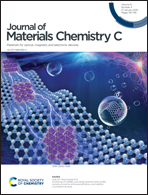First-principles study of aziridinium tin iodide perovskites for photovoltaics
Abstract
Solar cells with organic–inorganic lead halide perovskites have attracted great attention in the last decade. Herein, we propose lead-free halide perovskite (CH2)2NH2SnI3, as well as alloys (CH2)2NH2SnI3−xBrx, to avoid the toxicology of lead element. We find that the perovskite (CH2)2NH2SnI3 has much better stability than CH3NH3PbI3 and possesses a band gap of 1.06 eV. Meanwhile, the alloy (CH2)2NH2SnI2Br has an ideal band gap of 1.31 eV for photovoltaics. The alloy (CH2)2NH2SnI3−xBrx is proved to have higher optical absorption than CH3NH3PbI3 in general. We thus propose that the lead-free perovskite (CH2)2NH2SnI3 and alloys (CH2)2NH2SnI3−xBrx are probably excellent candidates for stable and high-performance photovoltaic absorber materials.



 Please wait while we load your content...
Please wait while we load your content...